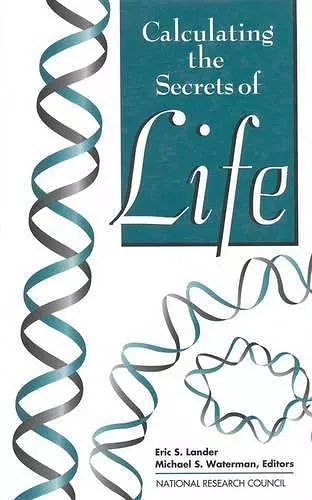Calculating the Secrets of Life
Contributions of the Mathematical Sciences to Molecular Biology
National Research Council author Division on Engineering and Physical Sciences author Commission on Physical Sciences, Mathematics, and Applications author Committee on the Mathematical Sciences in Genome and Protein Structure Research author Michael S Waterman editor Eric S Lander editor
Format:Paperback
Publisher:National Academies Press
Published:6th May '95
Currently unavailable, our supplier has not provided us a restock date

As researchers have pursued biology's secrets to the molecular level, mathematical and computer sciences have played an increasingly important role—in genome mapping, population genetics, and even the controversial search for "Eve," hypothetical mother of the human race.
In this first-ever survey of the partnership between the two fields, leading experts look at how mathematical research and methods have made possible important discoveries in biology.
The volume explores how differential geometry, topology, and differential mechanics have allowed researchers to "wind" and "unwind" DNA's double helix to understand the phenomenon of supercoiling. It explains how mathematical tools are revealing the workings of enzymes and proteins. And it describes how mathematicians are detecting echoes from the origin of life by applying stochastic and statistical theory to the study of DNA sequences.
This informative and motivational book will be of interest to researchers, research administrators, and educators and students in mathematics, computer sciences, and biology.
Table of Contents- Front Matter
- Chapter 1 The Secrets of Life: A Mathematician's Introduction to Molecular Biology
- BIOCHEMISTRY
- CLASSICAL GENETICS
- MOLECULAR BIOLOGY
- THE RECOMBINANT DNA REVOLUTION
- MOLECULAR GENETICS IN THE 1990S
- THE HUMAN GENOME PROJECT
- COMING ATTRACTIONS
- REFERENCES
- Chapter 2 Mapping Heredity: Using Probabilistic Models and Algorithms to Map Genes and Genomes
- The Concept of Genetic Maps
- Challenges of Genetic Mapping: Human Families and Complex Traits
- MAXIMUM LIKELIHOOD ESTIMATION
- Efficient Algorithms
- Excursion: Susceptibility to Colon Cancer in Mice and the Large Deviation Theory of Diffusion Processes
- Assembling Physical Maps by "Fingerprinting" Random Clones
- Excursion: Designing a Strategy to Map the Human Genome
- CONCLUSION
- REFERENCES
- Chapter 3 Seeing Conserved Signals: Using Algorithms to Detect Similarities between Biosequences
- FINDING GLOBAL SIMILARITIES
- Visualizing Alignments: Edit Graphs
- The Basic Dynamic Programming Algorithm
- FINDING LOCAL SIMILARITIES
- Variations in Gap Cost Penalties
- The Duality Between Similarity and Difference Measures
- Aligning More Than Two Sequences at a Time
- K-Best Alignments
- Approximate Pattern Matching
- Parallel Computing
- COMPARING ONE SEQUENCE AGAINST A DATABASE
- Heuristic Algorithms
- Sublinear Similarity Searches
- OPEN PROBLEMS
- REFERENCES
- Chapter 4 Hearing Distant Echoes: Using Extremal Statistics to Probe Evolutionary Origins
- Sequence Alignment
- Alignment Given
- Alignment Unknown
- Alignment Given
- Alignment Unknown
- APPLICATION TO RNA EVOLUTION
- TWO BEHAVIORS SUFFICE
- RNA EVOLUTION REVISITED
- REFERENCES
- Chapter 5 Calibrating the Clock: Using Stochastic Processes to Measure the Rate of Evolution
- OVERVIEW
- THE COALESCENT AND MUTATION
- The Ewens Sampling Formula
- Top-down
- Bottom-up
- The Infinitely-Many-Sites Model
- K-Allele Models
- The Finitely-Many-Sites Models
- Approximations for the Ewens Sampling Formula
- Combinatorial Assemblies
- Other Combinatorial Structures
- The Large Components
- WHERE TO NEXT?
- Likelihood Methods
- Discussion
- General-Purpose References
- Detailed References
- Chapter 6 Winding the Double Helix: Using Geometry, Topology, and Mechanics of DNA
- DNA GEOMETRY AND TOPOLOGY: LINKING, TWISTING, AND WRITHING
- APPLICATIONS TO...
ISBN: 9780309075022
Dimensions: unknown
Weight: unknown
300 pages